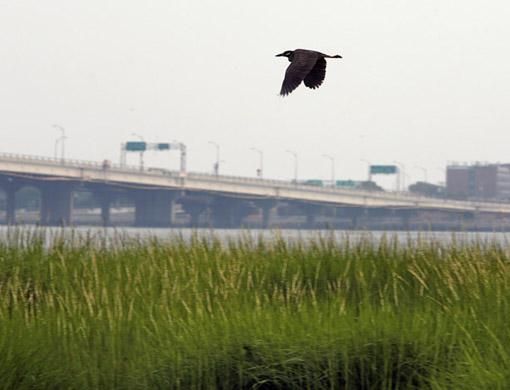If we view cities as densely populated areas surrounded by increasingly less populated and wilder land, then New York's Jamaica Bay wetlands present this phenomenon in reverse.
The 39-square-mile saltwater marsh at the far eastern edge of Queens and Brooklyn is a piece of nature engulfed by the country's largest metropolitan area. Since the mid-1990s, the marsh, which hosts a multitude of fish and bird species, has been disappearing at an accelerating rate.
“Something has dramatically changed,'' says Dan T. Mundy, a battalion leader for the New York City Fire Department and a lifelong resident of Broad Channel, Queens, an island community in the bay. “The marsh has lost its ability to hold itself together.''
Scientists have a list of possible culprits. None — excess nutrients and the hardening of the bay's shoreline, for example — is mutually exclusive. Indeed, the combination of several factors — what one scientist calls “a destructive synergy'' — is likely behind the marsh's degradation.
As such, the bay is something of a case study for the predicament of coastal wetlands in the United States and the world in general.
City, state and federal agencies are hashing out, and in some cases already implementing, various wetland-restoration strategies in Jamaica Bay.
Proposed solutions include lowering nutrient influx and mimicking natural sedimentation by carting in sand. But the abiding question is: Will these efforts address the underlying causes of marsh degradation?
As of 2003, only 37 per cent of the marshland that existed here in 1951 remained. A 2001 report by the New York State Department of Environmental Conservation (DEC) concluded that, at the rates of loss then recorded, the marshes would disappear by 2024. A 2007 update by the Jamaica Bay Watershed Protection Plan Advisory Committee found that the loss had accelerated again, and revised the “no marsh'' date to 2012.
Scientists and residents alike would like to avoid total marsh loss for a slew of reasons. The spongy soil topped by tall grasses acts as buffers against storm surges. Many think Hurricane Katrina would have been less devastating had the Gulf Coast's wetlands been intact and able to slow and absorb the storm surge.
Wetland ecosystems also host a biodiversity rivalling that of coral reefs. They serve as a nursery for fish that, as adults, move to the open sea. And they sequester carbon as peat, keeping climate-warming greenhouse gases out of the atmosphere.
At a July conference on wetlands in Brazil, scientists stressed the “carbon sink'' function of wetlands.
And if rising temperatures or more direct human disturbance lead to more wetland drying, scientists worry that the carbon released will further warm the planet.
“It's a feedback loop,'' says Eugene Turner, a professor at Louisiana State University's Coastal Ecology Institute in Baton Rouge, who attended the Brazil conference.
Saltwater marshes require specific conditions to thrive: enough seawater to stay wet but not so much as to drown. Sea levels have already risen nearly a foot along the Eastern Seaboard during the past 150 years, due partly to subsidence and partly to thawing polar regions.
Locally, dredging has further altered tidal fluctuations by changing the “prism'' of the bay, says Larry Swanson, director of Stony Brook University's Waste Reduction and Management Institute on Long Island. The increased depth amplifies the tide, with highs and lows 8 to 10 inches above and below historical extremes, he says.
The DEC has asked New York City's Department of Environmental Protection (NYCDEP) to address the issue of water quality in Jamaica Bay. In response, the DEP proposed a list of solutions in the 2007 Jamaica Bay Watershed Protection Plan. Among other things, the list included upgrading wastewater-treatment plants to reduce the nitrogen load. But “there's basically been a backsliding'' since then, says Brad Sewell, senior attorney with the Natural Resources Defence Council in New York.
Citing the failure of limiting nitrogen in halting marsh degradation in places such as Long Island Sound, a more recent NYCDEP white paper seems to de-emphasise this approach, which, it estimates, could cost city residents $6 billion.
“Nitrogen levels have not been linked to marshland disappearance,'' it states. “Upgrades will not attenuate this loss.''
But scientists have several working hypotheses explaining how excess nutrients may harm wetlands. One is by making life too easy for the marsh grasses.
“When plants get enough nutrients, they don't produce as many roots,'' says Dr Turner. “When the storms come, they don't have enough roots to hold the soil.''
Several restoration projects are already under way in Jamaica Bay. A pilot project is in the works to reintroduce oysters, absent since the 1930s. A single adult oyster can filter up to 50 gallons of water a day, clearing algae from the water.
“We know we can get them to survive,'' says John McLaughlin, NYCDEP's director of ecological services. “The next step is, can we get them to reproduce.''
Beginning in 2004, government agencies including the National Park Service and the Army Corps of Engineers planted spartina on hassocks fortified with dredged sand.
Four years later, the restoration effort is considered a success. But ongoing losses are greater than what is being restored. Without addressing the underlying causes of degradation, restoration efforts may not be sustainable in the long term, Sewell says.
Given the accelerating loss, some say there is little time to waste. “We can't just afford to let it go and not try to take all reasonable actions to keep it healthy,'' Swanson says.
“It may cost us in the short term, but [it is] worth it in the long term.''
Rumble in the marsh
New York's Jamaica Bay embodies the world's wetland woes



